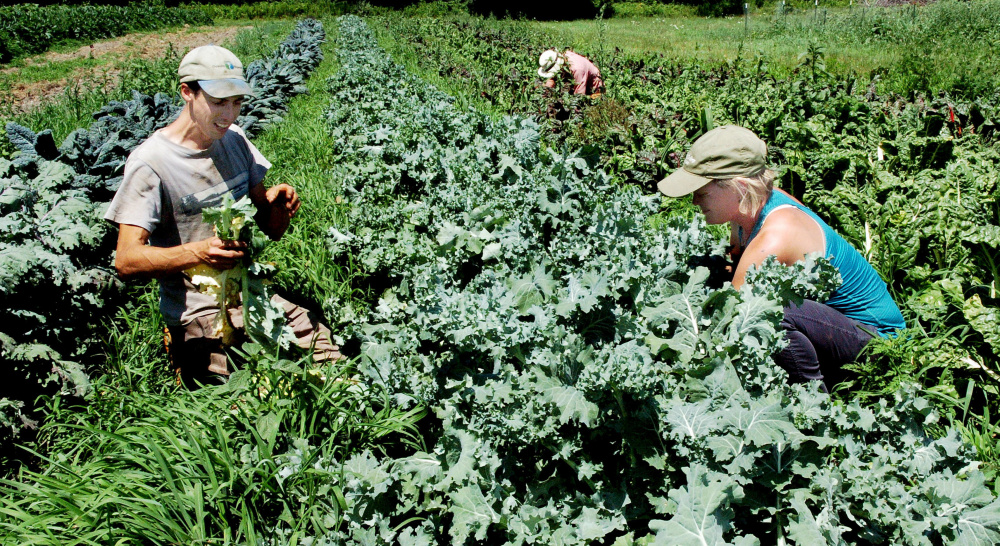Small farms have driven Maine’s agricultural renaissance, as young farmers reclaim land for food production at a rate not seen anywhere else in the country.
As a result, Maine’s economy is poised to benefit greatly from the relatively new emphasis on healthy local food, as long as the state can find a way to harness the power of all those small producers.
That’s the message from two reports released in the last year, and it’s one that needs to be heard. Agriculture, among the oldest of industries, can be new again, and it can help enrich all parts of the state, north and south. But only if it’s given the attention it deserves.
TWO REPORTS
The latest report, from Maine Food Strategy, a broad coalition of individuals, businesses and organizations involved in food production, outlines five goals for capitalizing on all the talent and resources in Maine agriculture.
The report calls for measurable annual increases in global and in-state market share for foods grown and processed in Maine; improved ability for businesses across the supply chain to manage growth and changes in the marketplace; improved wages and benefits for workers; public policies supportive of local agriculture; and a dedication to providing resources to people who are not getting enough food.
To accomplish those goals, the report says, food producers and processors must be more seamlessly connected – all those various small levers and pulleys must be put together in the right way to make a powerful machine.
That means more awareness of the value of local food, better financing and incentives to encourage growth, identification and widespread use of the best business models for Maine, improved workforce development, and the proliferation of cooperatives that allow many small producers to gain the benefits of scale.
The Maine Food Strategy report builds on an analysis last year from the Harvard School for Business and Government, which also called for better coordination among food producers, institutions and public officials.
The state, the Harvard report said, needs a dedicated business accelerator program that can provide networking and coaching to growing businesses, as well as aid in finding investors and developing a business plan. Maine’s various trade groups need to work together, as well, to cut out inefficiencies.
MAINE’S HIGH CEILING
That would help Maine farmers and fishermen, who do well on direct sales to consumers, scale up and reach outside the state to bigger markets, a necessity for the industry to reach its full potential.
Similar programs worked well in Oregon and Vermont, where the Farm to Plate initiative launched in 2009 led to 35 percent growth in food manufacturing jobs, and the addition of 4,189 agricultural jobs.
The ceiling in Maine is even higher. The state has built a reputation for its local, environmentally friendly food industry. The products and innovation coming out of the state – think lobster, craft beer, aquaculture and organic food – show Maine can punch above its weight when it comes to food production, and the rest of New England is looking our way.
The eventual rise of fuel prices and the developing water scarcity in California and the Midwest, among other factors, mean that New England will have to produce more of its own food in the future.
The New England Food Vision imagines a time when the region produces half of its own food – and we should imagine it, too.
Now only 5 percent of land in New England is used for agriculture. To reach the goal – to go from 9 percent local food to 50 percent – another 10 percent of the region’s land would have to be converted to agriculture, and most of the available land is in Maine.
That is a remarkable opportunity to build an industry that could rival paper at its most recent peak, one that would benefit Aroostook and Somerset counties as much as Cumberland and York, and keep local dollars flowing locally, where they do the most good.
Copy the Story LinkSend questions/comments to the editors.



Success. Please wait for the page to reload. If the page does not reload within 5 seconds, please refresh the page.
Enter your email and password to access comments.
Hi, to comment on stories you must . This profile is in addition to your subscription and website login.
Already have a commenting profile? .
Invalid username/password.
Please check your email to confirm and complete your registration.
Only subscribers are eligible to post comments. Please subscribe or login first for digital access. Here’s why.
Use the form below to reset your password. When you've submitted your account email, we will send an email with a reset code.